The great cormorant (Phalacrocorax carbo) is a large, widely distributed waterbird known for its versatile hunting skills, striking black plumage, and distinctive wing-drying posture. It inhabits coastal and inland waters across Europe, Asia, Africa, Australia, and parts of North America, thriving in both marine and freshwater environments. An agile diver, it hunts fish with precision, using powerful strokes and specialized vision. The species has a long history of interaction with humans, from its use in traditional fishing practices in Asia to its modern conflicts with fisheries. Once heavily persecuted, it has made a strong recovery and remains one of the most widespread cormorant species today.
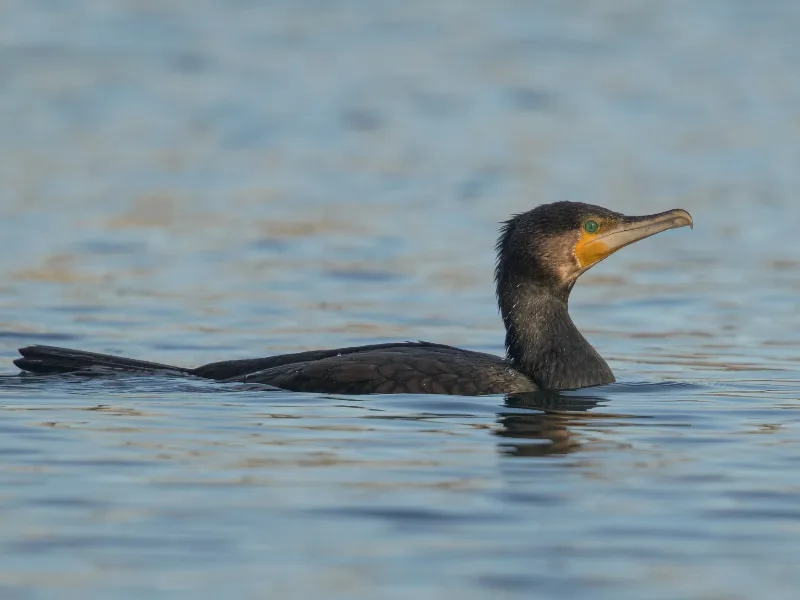
| Common name | Great cormorant |
| Scientific name | Phalacrocorax carbo |
| Alternative names | Black shag, kawau, black cormorant |
| Order | Suliformes |
| Family | Phalacrocoracidae |
| Genus | Phalacrocorax |
| Discovery | Described by C. Linnaeus in 1758 as Pelecanus carbo, later placed in Phalacrocorax by M. J. Brisson in 1760 |
| Identification | Large black waterbird with a long hooked bill, yellow throat patch, and white breeding-season filoplumes on the head and thighs |
| Range | Found across Europe, Asia, Africa, Australia, and parts of North America; occurs in coastal and inland waters |
| Migration | Some populations are migratory, especially in northern and eastern Europe, while others remain resident year-round |
| Habitat | Prefers lakes, rivers, coastal waters, estuaries, and islands for breeding; roosts in trees, cliffs, and artificial structures |
| Behavior | Expert diver; hunts fish underwater using strong strokes; perches with wings spread to dry; forms large communal roosts |
| Lifespan | Typically 6-10 years in the wild, though some individuals exceed 20 years; high juvenile mortality lowers average survival |
| Diet | Primarily fish; diet varies by season and habitat; hunts alone or in coordinated group foraging |
| Conservation status | Least Concern (IUCN); populations increasing globally, though localized culling and habitat pressures persist |
| Population | Estimated 1.4-2.1 million individuals globally; European breeding population around 828,000-1,030,000 mature individuals |
Discovery
The great cormorant was formally described in 1758 by the Swedish naturalist Carl Linnaeus in the 10th edition of Systema Naturae. Linnaeus originally placed the species under the binomial name Pelecanus carbo, reflecting an early classification that grouped cormorants with pelicans. However, in 1760, the French zoologist Mathurin Jacques Brisson introduced the genus Phalacrocorax, where the great cormorant is now classified along with 11 other species. The genus name derives from Latinized Ancient Greek: phalakros, meaning “bald,” and korax, meaning “raven,” referencing its dark plumage and hooked beak. The species epithet carbo, meaning “charcoal” in Latin, describes its black coloration.
Linnaeus specified the type location simply as “Europe,” but in 1920, the German ornithologist Ernst Hartert restricted it to the rock-nesting form of the North Atlantic Ocean to clarify its regional identity. Over time, taxonomic studies have recognized regional variations, leading to the classification of multiple subspecies, each adapted to specific environments. Genetic studies suggest that the Japanese cormorant (Phalacrocorax capillatus) is closely related to the great cormorant and may be embedded within P. carbo, highlighting potential revisions in its evolutionary classification.
Six subspecies of the great cormorant are currently recognized:
- P. c. carbo. Found in North Atlantic coasts, including Europe, Greenland, and eastern North America.
- P. c. sinensis. Widespread in Europe and Asia, breeding in inland lakes, wetlands, and lowland rivers.
- P. c. hanedae. Native to the Sea of Japan, with a restricted range in Japan and Korea.
- P. c. novaehollandiae. Distributed across Australia and New Zealand, where it occupies both coastal and inland habitats.
- P. c. maroccanus. Found in Northwest Africa, primarily along the Atlantic and Mediterranean coasts.
- P. c. lucidus. The white-breasted cormorant, occurring in sub-Saharan Africa, particularly in freshwater lakes and estuaries.
The great cormorant’s longstanding association with humans, particularly in traditional fishing practices, has made it a subject of scientific and historical interest. Ongoing research continues to explore its evolutionary adaptations, ecological roles, and interactions with fisheries, contributing to a deeper understanding of its significance in aquatic ecosystems.
Identification
The great cormorant is a large, heavy-bodied waterbird with a long neck, hooked bill, and webbed feet, adapted for an aquatic lifestyle. It is one of the largest cormorant species, displaying significant regional variation in size and plumage characteristics. Adults measure between 70 and 102 centimeters (27.5-40 inches) in length, with a wingspan of 121 to 160 centimeters (47.5-63 inches). Weight ranges from 1.5 to 5.3 kilograms (3.3 to 11.7 pounds), with males typically being larger and heavier than females. Some of the heaviest individuals have been recorded in North Atlantic populations, whereas birds in Asia and Africa tend to be smaller.
The species has predominantly black plumage, often displaying a bluish-green gloss under direct light. The wings are slightly browner, and the face and gular region are yellow, bordered by small white feathers. During the breeding season, adults develop short white filoplumes on the head and neck, along with a white thigh patch that disappears outside of the breeding period. During egg-laying, a yellow to scarlet patch appears behind and below each eye, though its intensity varies among individuals. The bill is thick and hooked, with a pale to yellowish base and a darker upper mandible. The legs and webbed feet are dark, enhancing the bird’s strong swimming ability.
Juveniles have a browner, more mottled appearance, with paler underparts and less distinct facial markings. Their bill is uniformly grayish, and their gular region is duller compared to adults. As they mature, their plumage darkens gradually, reaching full adult coloration by their second or third year.

Individual variation in plumage is significant, particularly in the extent of white markings, making it difficult to distinguish subspecies based on appearance alone. In general, African populations (P. c. lucidus) tend to have more extensive white on the head and neck, while European birds (P. c. carbo) typically have fewer white filoplumes than Asian populations (P. c. sinensis). However, there is considerable overlap, and these characteristics are not always reliable for subspecies identification.
In flight, the great cormorant is recognizable by its broad wings, long neck held straight, and slow, powerful wingbeats. Unlike herons, it does not retract its neck in flight. When swimming, it sits low in the water, with only the head and upper neck visible above the surface. A notable behavioral trait is its wing-drying posture – after diving, the bird perches with wings outstretched, a behavior essential for drying its feathers, which are not fully waterproof. This reduced waterproofing helps decrease buoyancy, allowing for more efficient underwater pursuit of fish.

A rare albino variation has been recorded in the species. These individuals, lacking normal pigmentation, face significant survival challenges due to poor eyesight and hearing, reducing their ability to hunt and evade predators.
Vocalizations
The great cormorant is generally quiet outside the breeding season, with vocal activity concentrated in colonial nesting sites. Its vocal repertoire consists of low-pitched, guttural sounds used primarily for courtship, territorial defense, nest interactions, and chick-parent communication. Unlike songbirds, it does not produce complex melodies but relies on broadband calls with low-frequency emphasis suited for noisy breeding colonies.
Listen to the great cormorant calls:
During the breeding season, males are the most vocal, using advertisement calls to attract mates and establish territories. These calls are low-frequency pulses, often accompanied by visual displays such as head-throwing and wing movements. Once paired, mates exchange nest relief calls when switching incubation duties. Returning adults emit landing calls, and aggressive interactions between neighbors or intruding individuals result in harsh, short warning calls. Nestlings produce begging calls, which increase in intensity as they grow, helping parents identify and prioritize feeding.
Acoustic studies have shown differences between male and female calls, with males producing deeper, longer calls. Individual variation in vocalization patterns suggests that calls may function as recognition signals among mates and offspring.
Although largely silent when foraging, great cormorants can emit alarm calls in response to predators. These calls are louder and more chaotic, sometimes triggering a collective response within the colony. However, the species relies more on visual displays and body language than vocalizations for communication outside the breeding period.
Hearing studies suggest that great cormorants are most sensitive to frequencies around 1-2 kHz, aligning with their own vocal range. This adaptation helps them detect and recognize conspecific calls, but their sensitivity to higher frequencies is limited compared to some other seabirds. Given their reliance on low-frequency sounds, increasing anthropogenic noise pollution in wetland and coastal habitats could interfere with their communication, particularly during breeding.
Range
The great cormorant is one of the most widely distributed cormorant species, found across Europe, Asia, Africa, Australia, and North America. It occupies a range of aquatic habitats, including coastal shorelines, estuaries, rivers, lakes, and reservoirs, adapting well to both marine and freshwater environments. Despite its wide distribution, distinct subspecies have developed regional adaptations, influencing their migration patterns and habitat preferences.
Six subspecies are currently recognized:
- P. c. carbo. Found along North Atlantic coasts, including Greenland, Iceland, the British Isles, and northern Europe. This is the largest subspecies, primarily coastal and non-migratory, though some northern populations move south in winter.
- P. c. sinensis. Occurs in continental Europe, North Africa, and Asia. It is more freshwater-adapted and displays complex migratory patterns, with breeding populations in Denmark, The Netherlands, Germany, and Poland migrating to the Mediterranean and North Africa for winter.
- P. c. hanedae. Restricted to Japan and Korea, this subspecies has recently expanded to Hokkaido. It is largely resident, though some birds move south in winter.
- P. c. novaehollandiae. Native to Australia and New Zealand, this subspecies is mainly sedentary, with only local movements in response to water levels and food availability.
- P. c. maroccanus. Found in northwest Africa (Morocco to Mauretania), this subspecies inhabits coastal and inland waters and is mostly non-migratory.
- P. c. lucidus. Distributed across sub-Saharan Africa, often referred to as the white-breasted cormorant due to its distinctive white head and neck markings. It is largely resident, with some seasonal movements influenced by water availability.
Migration
Migration in the great cormorant varies by subspecies, latitude, and environmental conditions. While some populations remain year-round residents, others undertake seasonal movements to avoid cold temperatures and food shortages. Migration strategies differ among coastal and inland populations, with the latter showing greater migratory tendencies due to harsher winter conditions.

In northern Europe, P. c. sinensis is a partial migrant, with breeding populations in Denmark, the Netherlands, and Germany migrating southward to France, Italy, and North Africa for the winter. First-year birds travel farther south than adults, while males tend to winter further north than females, likely due to their larger body size and ability to compete for early nesting sites. Post-breeding dispersal occurs between July and December, with peak southward migration in August–October. Many birds stage in Germany, the Netherlands, and Alpine lakes before reaching their wintering grounds. Spring migration (February-March) is more rapid, as adults return early to secure nesting territories.
In eastern Asia, P. c. hanedae has undergone recent range expansion, with new breeding colonies in Hokkaido since the late 1990s. Most birds from northern Japan migrate south in winter, though their exact wintering locations remain unclear due to limited tracking data.
Unlike its migratory relatives, P. c. carbo remains largely resident in the British Isles, Iceland, and North Atlantic coasts, with only minor seasonal shifts. However, birds breeding in northernmost latitudes (e.g., Norway, northern Scotland, and Greenland) may move southward along the coastlines during winter.
In Africa and Australia, P. c. lucidus and P. c. novaehollandiae are mostly sedentary, though some birds disperse locally in response to seasonal water availability. Freshwater populations in arid regions may shift to coastal environments during drought periods, while coastal birds generally remain in their breeding territories year-round.
Dispersal studies indicate that young birds often travel long distances before settling into stable breeding territories. Some first-year birds have been recorded moving over 900 kilometers (560 miles) from their natal sites, with inland-bred individuals frequently shifting to coastal wintering areas. This flexibility in movement suggests that freshwater and marine populations are not entirely distinct, as birds readily transition between the two environments based on resource availability.
The expansion of great cormorant populations in Europe has led to increasing conflicts with fisheries, prompting management interventions such as culling, nest destruction, and egg oiling to regulate numbers in certain regions. Despite these pressures, the species continues to thrive and expand, adapting to both natural and human-altered environments.
Habitat
The great cormorant occupies a wide range of aquatic environments, from coastal shorelines to freshwater lakes, rivers, and wetlands. Its habitat selection varies depending on subspecies, seasonal movements, and food availability, allowing it to thrive in both marine and inland ecosystems. While some populations remain year-round residents, others undertake seasonal migrations, moving between breeding and wintering habitats.
During the breeding season, great cormorants establish colonial nesting sites in areas that provide safety from predators and easy access to food. They often nest in trees, reedbeds, rocky cliffs, and artificial structures such as power line pylons and abandoned buildings. In inland environments, tree-nesting colonies can have a significant impact on vegetation, as guano accumulation leads to tree dieback and soil acidification, altering the structure of forested wetland habitats. Coastal colonies are usually more stable, as nesting on rocky outcrops and islands prevents extensive habitat destruction.
Beyond the breeding season, cormorants continue to rely on shallow water bodies where fish are abundant. They are commonly found in estuaries, tidal flats, lagoons, reservoirs, and slow-moving rivers, favoring locations with calm waters that allow for efficient diving. Some populations have also adapted to urban environments, frequenting artificial lakes, city canals, and even industrial ponds where human-altered fish populations provide a reliable food source.
In certain regions, cormorant populations have grown significantly, leading to conflicts with fisheries and concerns about their ecological impact. Large roosting and breeding colonies can eutrophicate water bodies, as high levels of nitrogen and phosphorus from guano contribute to algal blooms and water quality degradation. While such effects are more pronounced in densely populated colonies, the species remains an important indicator of wetland and coastal ecosystem health, reflecting changes in water quality and fish populations.
Despite these environmental challenges, the great cormorant continues to expand into new territories, adapting to diverse aquatic habitats across its range. Regional differences in habitat use are evident among subspecies, with P. c. carbo primarily inhabiting coastal cliffs and estuaries, while P. c. sinensis is more commonly found in freshwater lakes and rivers. In Africa, P. c. lucidus occupies both inland and coastal waters, while in East Asia, P. c. hanedae has recently established breeding colonies further north in response to changing conditions. These adaptations highlight the species’ flexibility and resilience, enabling it to persist in a variety of ecological settings.
Behavior
The great cormorant is a highly social waterbird that exhibits a range of adaptive behaviors, adjusting to seasonal changes, habitat conditions, and foraging demands. It is diurnal, spending most of the day fishing, preening, and roosting, while gathering in communal groups at night. Though often seen in large flocks, its behavior varies depending on the breeding season, foraging strategy, and interactions with other species, including humans.
Great cormorants are colonial nesters, forming dense breeding colonies in trees, reedbeds, rocky cliffs, and man-made structures. They show strong site fidelity, returning to the same nesting areas for multiple seasons. Within these colonies, aggression is common, particularly in competition for nest sites. Dominance is established through bill-gaping, wing-spreading, and head-thrusting displays, which can escalate into physical conflicts if space is limited. Despite territorial disputes, they tolerate close nesting proximity, benefiting from the safety of numbers against predators.
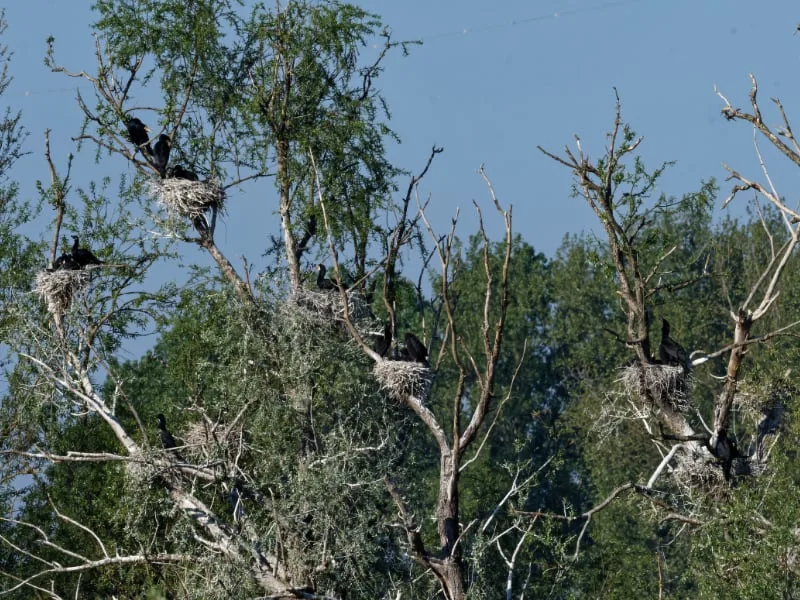
Outside the breeding season, cormorants continue to display strong social behavior, particularly when roosting and foraging. They often gather in large communal roosts, usually located in trees, coastal cliffs, or artificial structures near water. These sites provide protection from predators and serve as locations for social interactions and information sharing about food sources.
In flight, great cormorants move with steady, deep wingbeats, flying in loose formations between roosting and feeding sites. Unlike herons, they extend their necks forward in flight, making them easy to identify. When swimming, they sit low in the water, with only their head and neck visible above the surface. Their diving behavior is highly specialized, using powerful legs and webbed feet for propulsion while maneuvering efficiently to chase fish underwater.
After emerging from the water, cormorants frequently adopt their characteristic wing-drying posture, perching with wings fully extended. This behavior is necessary because their feathers are not fully waterproof, which reduces buoyancy for better diving efficiency but requires periodic drying to maintain insulation and flight capability.
Interactions with other species
Great cormorants frequently share breeding and foraging sites with other waterbirds, but interactions can be competitive or opportunistic. In mixed-species colonies, they often nest alongside grey herons, egrets, and ibises, though competition for space can lead to aggressive encounters. Cormorants may occasionally steal nest material from neighboring birds, particularly during the early breeding season.
Predators such as white-tailed eagles (Haliaeetus albicilla), foxes (Vulpes vulpes), and raccoons (Procyon lotor) pose threats to cormorant colonies. In response, cormorants rely on group defense, where multiple individuals will alarm-call, take flight, or mob a predator to deter attacks.
Behavior toward humans
The great cormorant has a long and conflicted history with humans, particularly in relation to fisheries and aquaculture. In many regions, cormorants are viewed as competitors for fish stocks, leading to active persecution in the form of culling, nest destruction, and deterrent measures. Their ability to exploit commercial fish farms and stocked lakes has made them a target for management efforts, with some countries implementing population control measures to limit their impact.
Despite these conflicts, great cormorants have also benefited from human-altered environments. They have successfully expanded into artificial lakes, reservoirs, and urban waterways, taking advantage of stable food supplies. In some parts of Asia, cormorants have historically been trained for fishing, with human handlers using harnesses to control their diving. Although this practice is now largely ceremonial, it reflects the species’ long-standing relationship with human societies.
Though often wary of humans in heavily hunted regions, cormorants in protected areas or urban settings can become remarkably tolerant, roosting on man-made structures and foraging near boats. Their adaptive behavior and ability to thrive in both natural and modified environments demonstrate their resilience and ecological flexibility.
Breeding
The great cormorant is a colonial breeder, forming large nesting aggregations in coastal and inland environments. Breeding colonies are typically located near wetlands, rivers, sheltered inshore waters, or estuarine habitats, ensuring proximity to abundant food sources. Colony size varies, with some containing only a few dozen pairs, while others exceed 2,000 breeding pairs.
Breeding seasons differ by geographic location and climate. In temperate regions, nesting begins in late winter to early spring, with egg-laying occurring between February and May. In warmer climates, breeding may occur year-round, with peaks in spring and autumn. Populations in northern latitudes or high-altitude regions breed later in the year due to colder conditions, with nesting sometimes delayed until April or May.
Pair formation and nesting behavior
Great cormorants are monogamous for a single breeding season, though they do not always retain the same mate in subsequent years. Pair formation occurs at breeding sites, with males initiating courtship through wing vibrations, head swinging, and upright posturing. These displays often take place on water surfaces or near nest sites, where males establish territories and attract females. Once paired, both adults participate in nest building, reinforcing their bond through mutual preening and territorial defense.
Pairs often return to the same nesting site each year, reusing and expanding existing nests. Nests are constructed from sticks, reeds, and aquatic vegetation, with a lining of finer material such as feathers. Nest placement varies depending on the availability of suitable structures – some colonies are found high in trees, while others nest on rocky cliffs, artificial structures, or directly on the ground on predator-free islands. Long-term use of nesting sites can lead to significant habitat degradation, particularly in tree-nesting colonies, where guano accumulation eventually kills vegetation.
Egg laying and incubation
Clutch size ranges from 3 to 5 eggs, with an average of 3.3 to 3.8 eggs per nest, though variation occurs depending on location and environmental factors. Eggs measure approximately 61-66 millimeters (2.4-2.6 inches) in length and 34-41 millimeters (1.3-1.6 inches) in width and are typically pale blue or green, sometimes covered with a chalky white layer. The incubation period lasts 28-31 days, with both parents alternating incubation duties. A notable adaptation in cormorants is their use of webbed feet to transfer warmth to the eggs, ensuring consistent heat distribution.
Chick development and parental care
Hatchlings are born altricial, meaning they are blind, featherless, and completely dependent on parental care. Both parents feed their young through regurgitation, with chicks pecking at the adult’s throat to stimulate food release. Parental feeding remains frequent during the first few weeks, gradually decreasing as chicks become more independent.

Water provisioning has been observed, with adults collecting water in their bills and pouring it into the chick’s mouth, a behavior believed to prevent dehydration in warm climates. Nestlings typically fledge between 50 and 60 days, though they remain partially dependent on their parents for up to 70 days before becoming fully independent.
Breeding success and mortality factors
Breeding success is highly variable, influenced by food availability, environmental conditions, and predation pressure. In high-altitude and northern populations, chick mortality rates are higher due to harsh weather conditions and strong winds that dislodge nests. Predators such as raptors, foxes, and raccoons target both eggs and chicks, particularly in ground-nesting colonies.
Human disturbance is another significant factor affecting breeding success. In some areas, colonies are abandoned due to fisheries conflicts, culling programs, or habitat destruction. When disturbed, cormorants may relocate and establish new breeding sites, sometimes leading to increased nesting in artificial or urban environments.
Despite these challenges, the great cormorant remains a highly adaptable breeder, capable of utilizing a wide range of nesting sites and adjusting to changing environmental conditions. The expansion of breeding populations in Europe and Asia highlights the species’ ability to exploit both natural and human-modified habitats, ensuring its continued reproductive success.
Lifespan
The great cormorant typically lives between 6 and 10 years in the wild, though some individuals may survive significantly longer under favorable conditions. The oldest known individual was recorded at 21 years and 9 months, though such cases are rare. Most cormorants experience high mortality rates early in life, which greatly reduces the average lifespan.
Mortality is highest during the first year, with studies indicating that up to 73% of juveniles do not survive. After this critical period, annual mortality rates decline but remain substantial, with some populations experiencing over 50% adult mortality per year. The primary causes of death include predation, starvation, entanglement in fishing gear, and human persecution. Eggs and chicks are particularly vulnerable to raptors, foxes, raccoons, and gulls, especially in ground-nesting colonies where they are more exposed. Juveniles that fail to establish effective foraging strategies often suffer from malnutrition, and food scarcity during severe winters can also impact adult survival.
Human-related mortality is a significant factor in many regions. Cormorants frequently become entangled in fishing nets or discarded nylon lines, leading to injuries, starvation, or drowning. In areas where they are considered a threat to fisheries, culling programs and nest destruction efforts have contributed to population declines. Despite these threats, great cormorants are adaptable birds that thrive in diverse aquatic environments. Their ability to adjust their foraging strategies and exploit different habitats has allowed many populations to remain stable, even in the face of high early-life mortality.
Diet
The great cormorant is a versatile piscivore, primarily feeding on small to medium-sized fish, though it occasionally consumes crustaceans, amphibians, and aquatic invertebrates. Its diet varies based on habitat, season, and prey availability, with cyprinids (roach, bream, chub) dominating freshwater diets and flatfish, eels, and cod being common in coastal regions. Most prey measures between 10 and 25 centimeters (4-10 inches), though fish as small as 5 centimeters (2 inches) and as large as 40 centimeters (16 inches) have been recorded. In winter, the species adapts by targeting more accessible fish, such as eels and pike, or shifting foraging locations.
Great cormorants are efficient divers, typically submerging for 20 to 60 seconds at depths of 1 to 10 meters (3.3-33 feet), though deeper dives beyond 20 meters (66 feet) have been recorded. They rely on underwater vision, but because their visual acuity is limited, they often detect prey at close range and capture it with rapid strikes. Unlike pursuit-diving seabirds, they do not chase prey over long distances, instead using a prey-flushing strategy, disturbing fish from hiding places. Their foraging behavior is adaptable, with individuals hunting alone in clear waters or cooperating in groups to herd fish in turbid or deep environments.
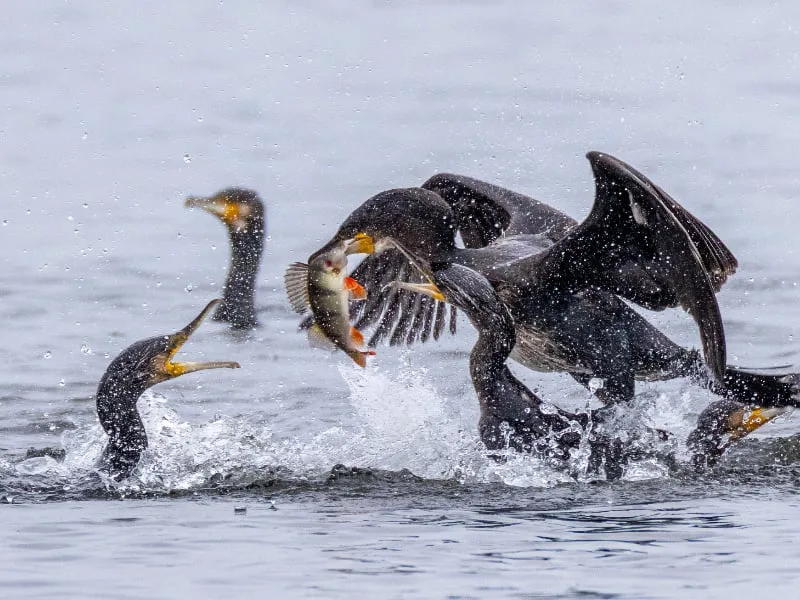
In cold climates, foraging strategies change to maximize energy efficiency. Arctic populations use a bimodal feeding pattern, with peak hunting times in morning and afternoon to align with fish activity. To minimize heat loss, they reduce foraging time to as little as one hour per day, preferring fewer but larger fish to sustain their energy needs. Unlike seabirds with waterproof plumage, cormorants absorb water, increasing heat loss. To compensate, they limit time in the water and rely on efficient energy management rather than increasing food intake.
The species’ ability to adjust hunting methods, target different prey, and modify foraging schedules ensures its survival in both temperate and extreme environments, making it one of the most adaptable aquatic predators.
Culture
The great cormorant has held varied meanings across different cultures, often associated with water, resourcefulness, and omens. In Greek folklore, a well-known story tells of a wool merchant who, after losing his shipment at sea, was transformed into a cormorant. Ever since, the bird has been seen diving into the water in search of his lost cargo. In Norwegian traditions, cormorants were believed to carry messages from the dead, and their presence near homes was thought to signal a spiritual warning. British superstitions also portrayed the bird as an omen – one well-documented case in 1860 linked the sighting of a cormorant on Boston Church’s steeple to a tragic shipwreck.
Beyond myth, cormorants have had a practical relationship with humans, particularly in traditional fishing practices. In Japan, they have been trained for centuries in a technique called ukai, while in China, cormorant fishing has been practiced for an equally long time, particularly along rivers such as the Yangtze. Though largely ceremonial today, this practice continues in select regions of Japan’s Nagara River and parts of southern China. In contrast, in parts of Africa, cormorants are seen as competitors for fish, with some communities historically trapping them near wetlands.
In modern times, the perception of cormorants has become more complex. The species has faced controversy in Europe and North America, where it is sometimes viewed as a threat to fisheries due to its high fish consumption. As a result, culling measures have been introduced in certain regions, while conservationists argue for their ecological importance. Meanwhile, cultural symbolism persists in literature and art – John Milton’s “Paradise Lost” (1667) depicts a cormorant as a symbol of deception, while in heraldry, the Liver Bird of Liverpool is often thought to have been inspired by a cormorant.
Despite these differing views, the great cormorant remains one of the most recognizable aquatic birds, playing a role in both human traditions and environmental discussions. Whether seen as a messenger, a skilled hunter, or a competitor, its image continues to shape cultural narratives worldwide.
Threats and conservation
The great cormorant is classified as Least Concern by the IUCN, with a large and increasing global population. The most recent estimates place the total population between 1.4 and 2.1 million individuals. In Europe, the breeding population is estimated at 828,000 to 1,030,000 mature individuals, showing continued growth in several regions.
Winter counts suggest around 1.2 million birds in Europe, with higher numbers recorded in late summer when breeding colonies are most active. The Baltic population, which was nearly eradicated in the 19th and early 20th centuries, has now recovered to 190,000-210,000 breeding pairs. While numbers have stabilized in Denmark, Germany, and Poland, populations continue to increase in eastern and northern regions, including Estonia, Finland, and Russia.
In Asia, populations remain stable in China, Japan, and India, though habitat destruction and water pollution in some areas have led to localized declines. In Africa, P. c. lucidus is widespread, particularly along coasts and large freshwater bodies. In Australia and New Zealand, P. c. novaehollandiae is considered stable, though some populations fluctuate in response to changing water levels and environmental conditions.
Threats
The increasing population of the great cormorant has led to ongoing conflicts with fisheries, particularly in regions where inland breeding has expanded. In several countries, fish farmers and commercial fisheries report significant losses due to cormorant predation, leading to population control measures. In the UK, regulated culling is permitted through annual licenses, while in Norway, approximately 10,000 cormorants are legally hunted each year for consumption. Despite these measures, illegal persecution, including unauthorized shooting and nest destruction, still occurs in some areas.
Another major threat comes from accidental entanglement in fishing gear. The species frequently forages in coastal and estuarine waters, where it is vulnerable to bycatch in gill nets and purse-seine fisheries. While large-scale mortality from entanglement has not been documented, localized incidents could pose risks to small or isolated populations. Habitat loss also remains a concern, particularly in areas where wetland drainage, pollution, and human disturbance affect breeding and foraging grounds. Nesting colonies may suffer from direct disturbance by boating activity or tourism, sometimes leading to reproductive failure or abandonment.
Conservation efforts
Legal protections play a crucial role in safeguarding the great cormorant. The species is covered under the African-Eurasian Waterbird Agreement (AEWA) and benefits from protections in numerous Important Bird Areas (IBAs) and Special Protection Areas (SPAs) across Europe. While it was once listed in Annex I of the EU Birds Directive, it was removed in 1997, giving individual countries more flexibility in managing their local populations. Population monitoring programs continue to track breeding success, migration routes, and population stability, providing essential data for conservation planning.
Efforts to mitigate human-wildlife conflicts have led to a combination of population control and non-lethal management strategies. Some countries implement controlled culling programs, while others focus on alternative approaches such as egg oiling, nest removal, and habitat modifications to deter cormorants from feeding in fish farms. Research into fisheries protection strategies, including the use of barriers and pond redesigns, aims to reduce the impact of cormorant predation without resorting to lethal measures. Conservation groups continue to advocate for balanced coexistence strategies, ensuring that both fish stocks and cormorant populations can be sustainably managed in the long term.
Similar species
Several cormorant species closely resemble the great cormorant (Phalacrocorax carbo), leading to frequent misidentifications. These species share similar plumage and body structure but can be distinguished by differences in size, bill shape, coloration, and habitat preference.
Japanese cormorant (Phalacrocorax capillatus)
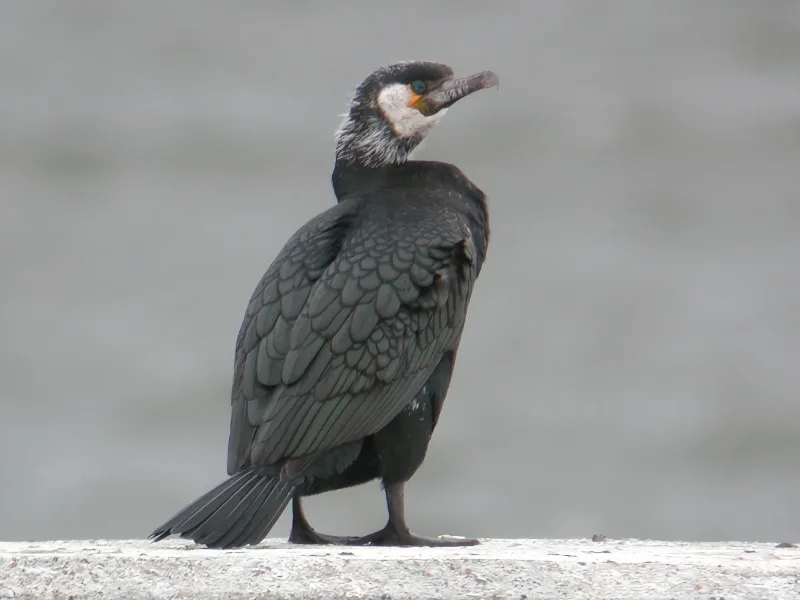
The Japanese cormorant is considered one of the closest relatives to the great cormorant and shares much of its coastal Asian range. Though similar in size and shape, the Japanese cormorant has a more curved bill and a whiter throat patch that extends further down the neck. It also appears slightly more slender, and genetic studies suggest it may be closely embedded within P. carbo.
European shag (Gulosus aristotelis)
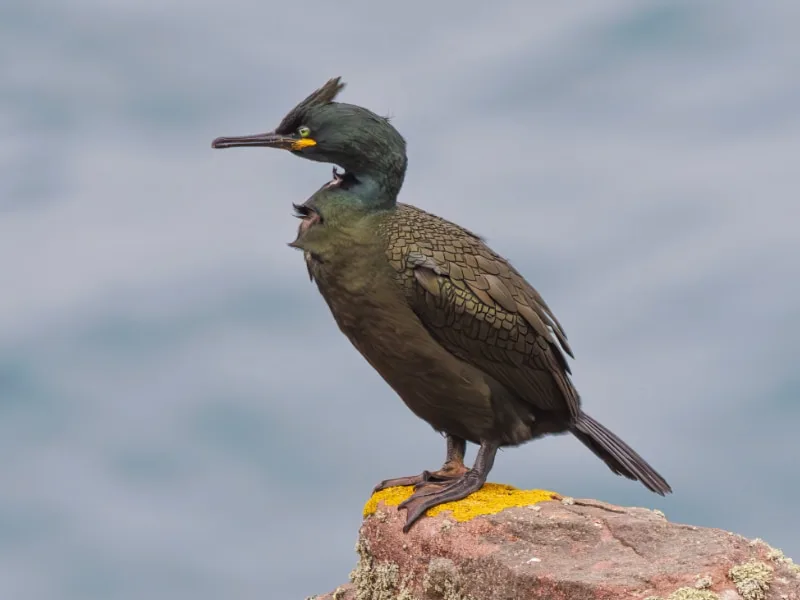
The European shag is one of the most commonly confused species in coastal Europe. While both birds have black plumage, the shag is noticeably smaller, slimmer, and has a more delicate bill. In breeding season, it develops a distinctive crest on its forehead, which is absent in the great cormorant. Additionally, its plumage often has a greenish sheen, whereas the great cormorant typically appears black with a bluish gloss.
Double-crested cormorant (Nannopterum auritum)
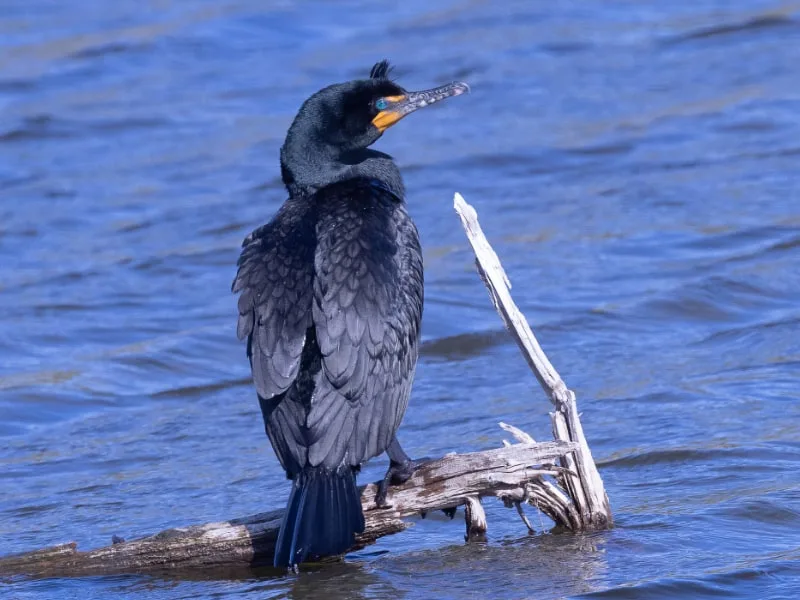
The double-crested cormorant occurs in North America and occasionally overlaps with the great cormorant in the North Atlantic region. Similar in body shape and dark coloration, it can be distinguished by its more orange-yellow throat patch and the presence of two small crests on its head during the breeding season. The great cormorant also tends to be bulkier, with a thicker neck and a heavier bill compared to the more streamlined double-crested cormorant.
Neotropic cormorant (Nannopterum brasilianum)
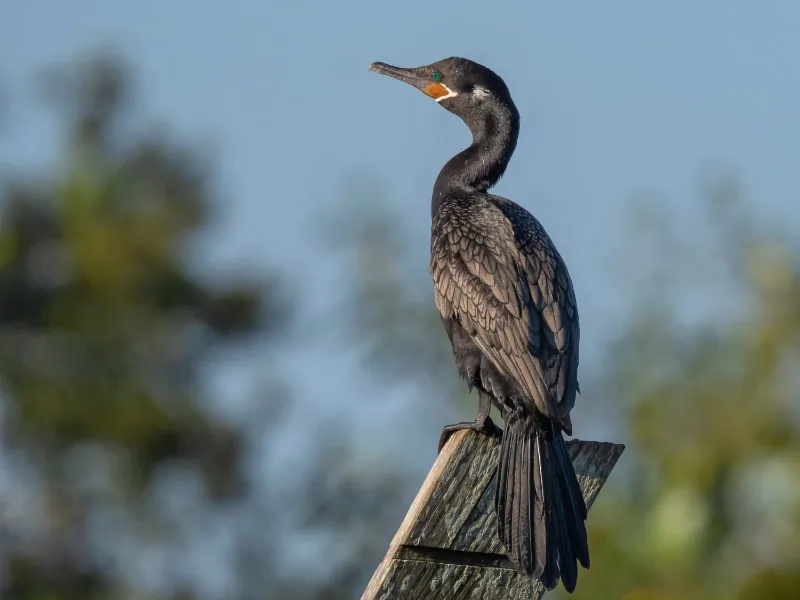
The neotropic cormorant is a smaller species found in Central and South America, where it sometimes overlaps with vagrant great cormorants. While both species have black plumage, the neotropic cormorant is more slender, has a longer tail, and features a distinctive thin strip of yellow facial skin extending backward from its bill. Unlike the great cormorant, which prefers coastal and large inland waters, the neotropic cormorant is more commonly found in smaller freshwater bodies such as rivers and lakes.
Pied cormorant (Phalacrocorax varius)
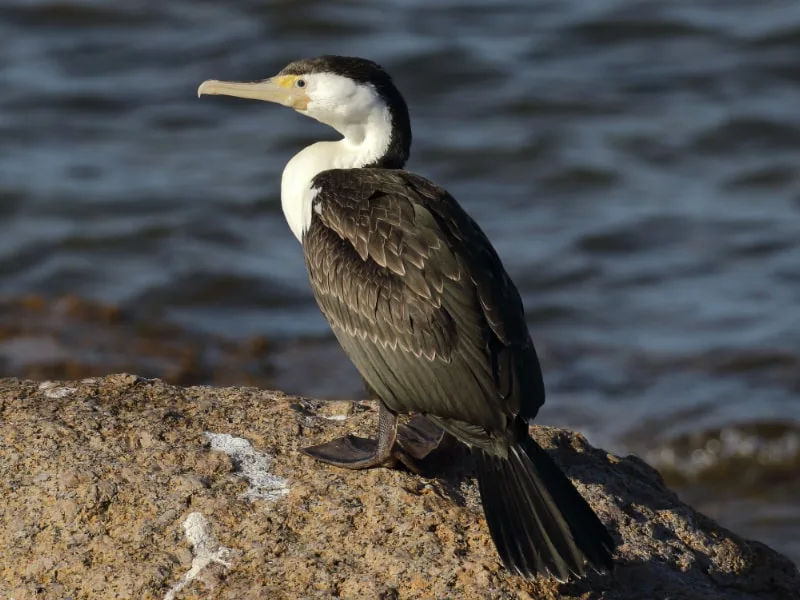
The pied cormorant shares a range with P. c. novaehollandiae in Australia and New Zealand but is easily distinguished by its contrasting black-and-white plumage. Unlike the great cormorant, which is entirely dark, the pied cormorant has a white belly, chest, and throat, making it more visually distinct. It also tends to have a shorter bill and prefers coastal and estuarine habitats, though both species can sometimes be seen in similar environments.
Future outlook
As the great cormorant continues to thrive across much of its range, the species faces a complex future shaped by environmental changes, human-wildlife conflicts, and ongoing conservation efforts. While its ability to adapt to both marine and freshwater habitats has contributed to its success, growing tensions with fisheries, habitat degradation, and climate-driven shifts in food availability could present new challenges. Sustainable management strategies will be essential to balance ecosystem health, fishery interests, and species conservation, ensuring that cormorant populations remain stable without unnecessary persecution.
At Planet of Birds, we recognize the great cormorant as a species emblematic of both resilience and controversy. Its historical recovery serves as a testament to the importance of legal protections and conservation initiatives, yet its interactions with humans continue to shape its perception. The future of the great cormorant will likely depend on ongoing research, responsible fisheries management, and informed policymaking, fostering coexistence rather than conflict. As new ecological and human pressures emerge, a science-based approach will be crucial in securing the species’ place in aquatic ecosystems worldwide.
